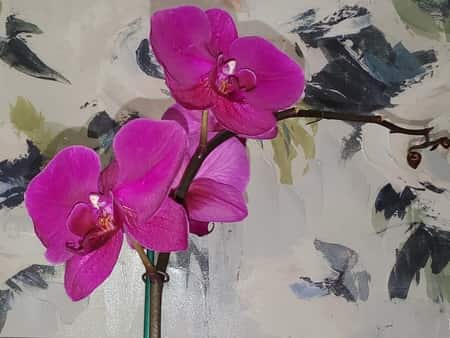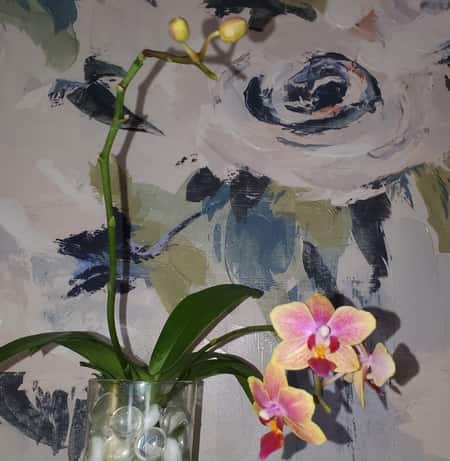Hydrogel beads (or water beads) have been used by florists for a long time to create orchid decorations to maintain the orchid stand in place for days on end. These beads are squishy, hard jelly-like balls, that resemble marbles. When wet, they expand to about a third of their size by retaining water. For a short-term potting medium, hydrogel beads are a life-saver, but not for long periods of time.
There are benefits of using hydrogel beads and also cons, so if you’re thinking about transferring your orchid, let’s looks at what can happen, both good and bad.
Overall, water beads are not good as orchid potting mediums in the long term even if they have a few positive attributes. Since they deprive your orchid of air movement and constantly maintain the roots wet, your orchid will eventually die.
Orchids prefer having moist roots, not soggy, wet ones. This consistent water around the roots that the hydrogel beads provide, induces root rot and will kill your orchid.
Orchids grow naturally attached to tress in the subtropical and tropical rainforest. This affects air circulation, lighting, pH, watering, and pollination—all that hydrogel beads cannot.Video: Hydrogel beads
https://www.youtube.com/embed/bPchIOg-uTI
Airflow with Orchid Hydrogel Beads

Consistent airflow sways through the tress and plays with the branches, leaves, and flowers.
It’s like walking through a hiking trail, but having a slight, cool breeze caress your hair as you walk, refreshing you.
A gentle breeze that never stops provides nutrients in small doses to the areal roots. Even after the daily thunderstorms and hard tropical showers that last not more than an hour, the roots can dry out with the gentle breeze.
Hydrogel beads don’t’ allow airflow.
The positive side is that they do allow air presence. The water beads are circular and do not touch each other on all sides. This allows air to remain inside the gaps of the orchid, but this air does not circulate. It just sits there. Since the water traps air exits in the bowl, there is no new air flowing in the potting medium, or exiting.
It’s stagnant air.
It’s not as bad as pure potting soil, though. There is some air, so terrestrial orchids might make it a little bit longer in hydrogel than epiphytes (orchids that attach themselves to trees) will, but even terrestrial orchids prefer to have some airflow.
That is why they don’t attach themselves to soil but to rocks and the top portion of leaf litter on the top of the forest floor. Airflow has to be an option.
Watering Orchids in a Hydrogel Beads Medium
Watering is where the real problem in hydrogel beads begins.
Hydrogel beads need a constant supply of water to expand. When they dry out, they shrink to about a third of the size. This water needs to be constant in the pot and covering all the beads (or at least most all) to be functional. This method places the roots in 100% contact with water.
You might be wondering what about hydroponics and full water culture. Don’t they have orchid roots in constant water? Yes and no. For full water culture, there is always a small layer of water in the bottom ¼ of the orchid vase, yet only a few roots ever come into contact with them.
The majority of the roots are exposed to air and receive the humidity from the water below. Every fifth day (this is an estimate, every orchid grower has their own schedule) the vase is filled up to the top and all the roots will become hydrated for 24 hours.
Then the water is emptied out. For more information on Full Water Culture, this guide will direct you in the most important steps, and this other guide will teach you how to transfer your orchid from bark to full water culture.
In a semi-hydroponic system, the orchid will rotate in a 2/5 day system, with drying out periods. For semi hydroponics, two days in water, five days to dry out. Or, if you have a full hydroponics, five days in less water, and two days to dry out. All depends on your environment and watering habits.

But in all of these, there is a common denominator: the drying out period. Hydrogel beads don’t allow that. If the beads dry out, they will shrink, pulling and yanking the tender velamen on the roots. This provides no stability for the orchid is the potting medium is expanding and shrinking constantly.
There is no possible way to keep the water beads hydrated to maintain their size, yet provide the drying put period for the orchid roots. The roots need to dry out—it’s mandatory.
Over-watering, either by watering too much or by watering too often—is the number one orchid killer of all times. The constant presence of water doesn’t let the orchid roots breathe, exchanging toxic gases for ones they can use to provide energy.
Lighting in the Orchid Potting Medium with Hydrogel Beads
Finally, it’s about time there was something positive in the mix: lighting. Hydrogel beads are perfect for allowing light into the potting medium. None of the other substrates and composts will work with orchids better than hydrogel beads when it comes to light.
Orchid roots are not made to be in a pot. None of them—even the terrestrial ones.
They hate to be potted. We pot them because we like to have orderly pots and nice displays. In nature, the roots are all areal, and there is no difference between a potted root and an areal root. (If you’re wondering, read this article that talks about areal roots.)
When attached to trees, the areal roots will get filtered sunlight flowing through the leaves above, and sun nurtures the roots. The velamen has chlorophyll, which transforms light into energy, useful for the plant’s survival.
When we force roots to grow inside the potting medium, they adapt to the new growing medium and change the ways they absorb nutrients. With no light, they become yellow loose their chlorophyll properties. (You can read more about yellow roots here, and whether you should cut them off during a repot or not.)
The now-potted roots will only absorb nutrients and water, and not sun.

If you have a clear plastic pot, the outer roots will still be green and the inner roots will be a pale-yellow color. This is just the presence or lack of chlorophyll in the roots, and whether they have sunlight or not.
The transparent or semi-transparent hydrogel beads allow sunlight not only to reach the outside of the pot, but to totally travel through it. What a better way to see how your roots are doing? There isn’t one.
The transparent beads are perfect to see the evolution of new roots, the absorption of water, when they turn from silver to green, and much more.
You’ll also be able to observe the slow progression of root rot—because that is what will happen if you keep your orchid roots in this media too long. Nice green healthy roots will slowly turn brownish-pale, then black on the ends. The black rot will travel up the roots and reach the stem, leaves, crown… Everything. It’s just not worth the payoff.
Hydrogel pH as a Potting Medium for Orchids
Another positive side to the hydrogel beads for orchids: the pH ratio. Most orchids like to have a slightly acidic potting medium. Neutral is around 7.0, but most orchids thrive in a lesser pH, of around 5.5 to 6.5. To give you an idea, tap water is on the alkaline side, more towards 7.5.
As a media that interacts with the roots, hydrogel does contain its own pH. It is a tad bit acidic, which most orchids love. Sphagnum moss also provides a more acidic medium, and that is why it’s so widely used. But the bad thing is that both the hydrogel beads and sphagnum moss will break down in time. When this decomposition occurs, the pH levels go haywire.
It’s quite easy to tell when sphagnum moss is no longer a viable medium. It’s compacted, usually has a distinct odor, and your orchid will start to turn yellow on the leaf tips. But how do you tell with hydrogel beads?
Each brand is made from a different company and it’s literally impossible to tell (without further long-term studies) if the beads are the best quality, and how long the “bead life” is.In all, hydrogel fails the test as an orchid potting medium. Florists have used water beads to stake the plant in place temporarily, as for shows, contests, events, and celebrations…but the hydrogel media is not recommended for long term orchid health.
It also isn’t recommended for an exposition of more than three days, since the beads will shrink and your orchid might topple over, depending on how big it is. In any case, falling over or not, your orchid will slowly die off.
If you have any questions, or if there is something that I haven’t covered in this tutorial, please let me know. I love to interact with other orchid enthusiasts, and we can all learn more.
In this article, published at www.orchids.org they explain a little more about hydrogel beads, and making natural beads from tapioca. I found it to be enlightening, but it still doesn’t change the way I feel about hydrogel beads.
published at www.orchids.org they explain a little more about hydrogel beads, and making natural beads from tapioca. I found it to be enlightening, but it still doesn’t change the way I feel about hydrogel beads.
The good thing about growing orchids is that there is no ONE way to do things, and ONE perfect method for everybody. It all depends on how you live, your environment, what works for you. That’s why interaction with other people to learn their methods is the best.
Don’t Stop Learning!
If you want to be included in more information and get a 14-page fertilization guide, please sign up for my newsletter. I don’t spam, but send emails out bi-monthly with some curious topics of interest. If you want more information, click here to go to a specific page on this website where I explain it more in detail.

Also, if you are looking for an orchid journal to keep your notes specifically about orchid care, check out my 2 solutions for that on this page. If note-keeping isn’t your thing, then there is a free excel spreadsheet that you can download. Click here for more information on how to do that.
If you subscribe to my newsletter, I will send you a 14-page guide on the main tips of orchid fertilizer. It is downloadable and you can print it out on your computer. I designed the guide to double up as a coloring book, just to make it fun.
If you’ve had any luck with hydrogel beads, please state that too. Maybe it just didn’t work for me, but your words could help others…
Happy Cultivating!

